Why you can trust Tom's Hardware
To read about our monitor tests in-depth, check out Display Testing Explained: How We Test PC Monitors. We cover brightness and contrast testing on page two.
Uncalibrated – Maximum Backlight Level
We dug deep into our database to find 4K 144Hz monitors to compare the XG27UQ’s performance. It turns out only Asus and Acer have screens that boast these two specs, as well as the XG27UQ's DisplayHDR 400 or better and Adaptive-Sync. We have the two standard-bearing screens, the Acer Predator X27 and Asus ROG Swift PG27UQ, along with the Acer Nitro XB273K and Acer Nitro XV273K. The Asus ROG Strix XG279Q is a 1440p resolution screen that tops out at 170 Hz but delivers everything else the 4K monitors do.
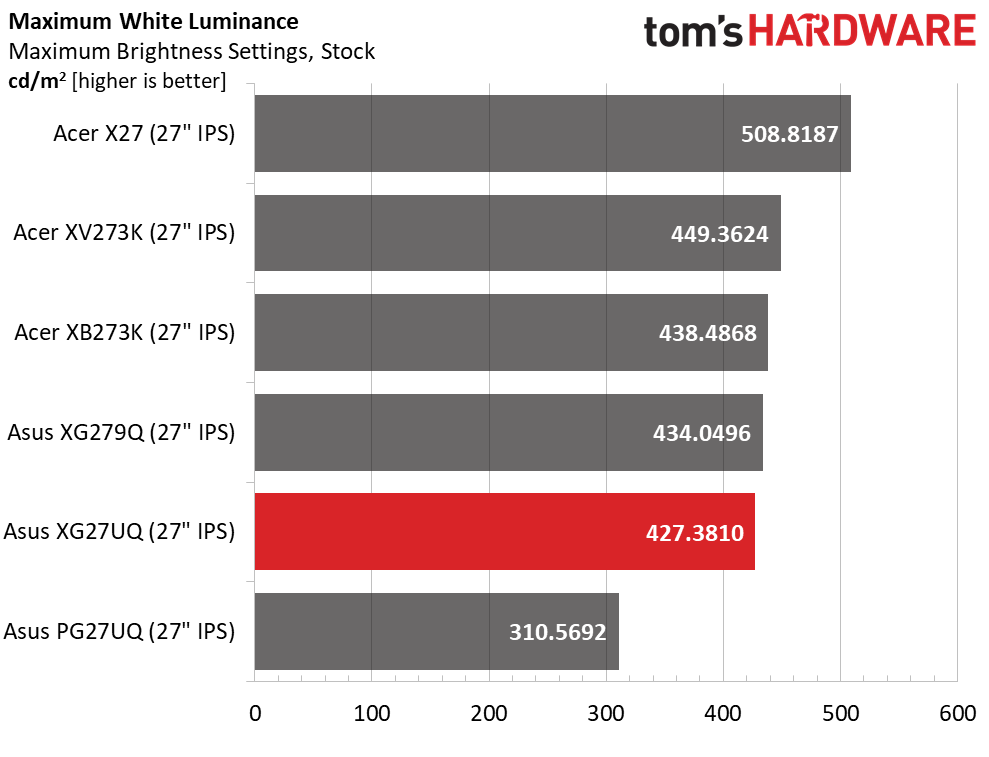
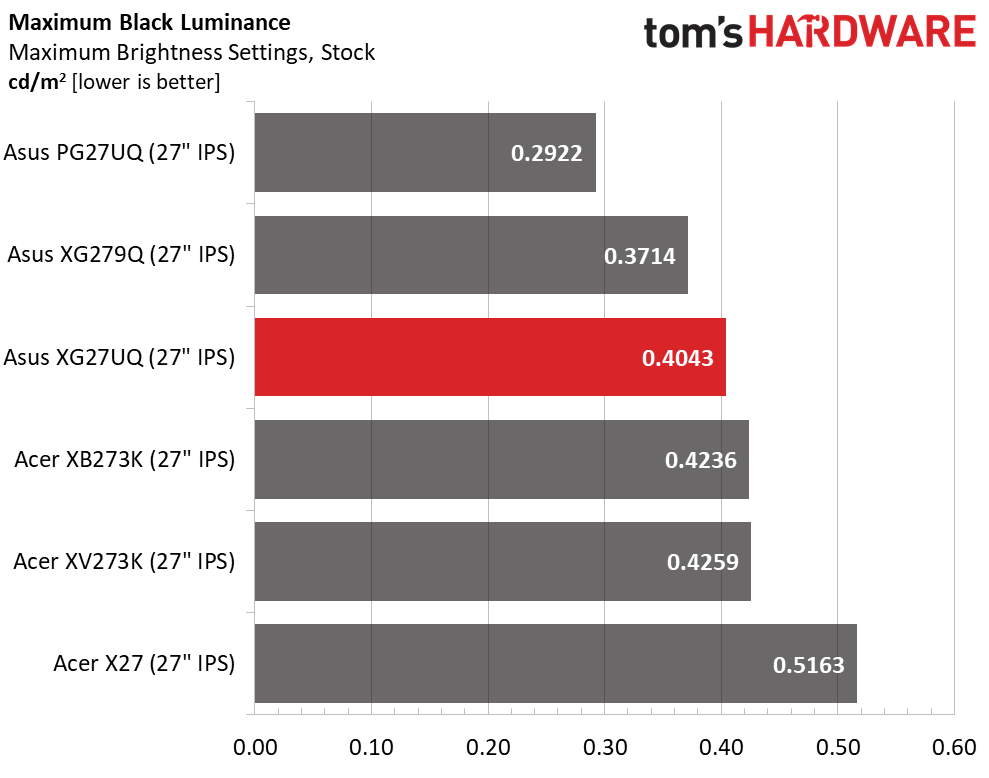

With over 427 nits available in SDR mode, the XG27UQ is more than bright enough for any environment. Even a covered outdoor space would be fine. The backlight has a 100-step adjustment and bottoms out at 56 nits, which is nearly ideal when the room is otherwise free of light. Black levels and contrast are typical of the average IPS panel at just over 1,000:1. This can be enhanced to just over 3,000:1 by engaging the Dynamic Dimming option. We normally don’t recommend dynamic contrast features as they tend to clip highlight and shadow detail, but this one worked well.
After Calibration to 200 nits
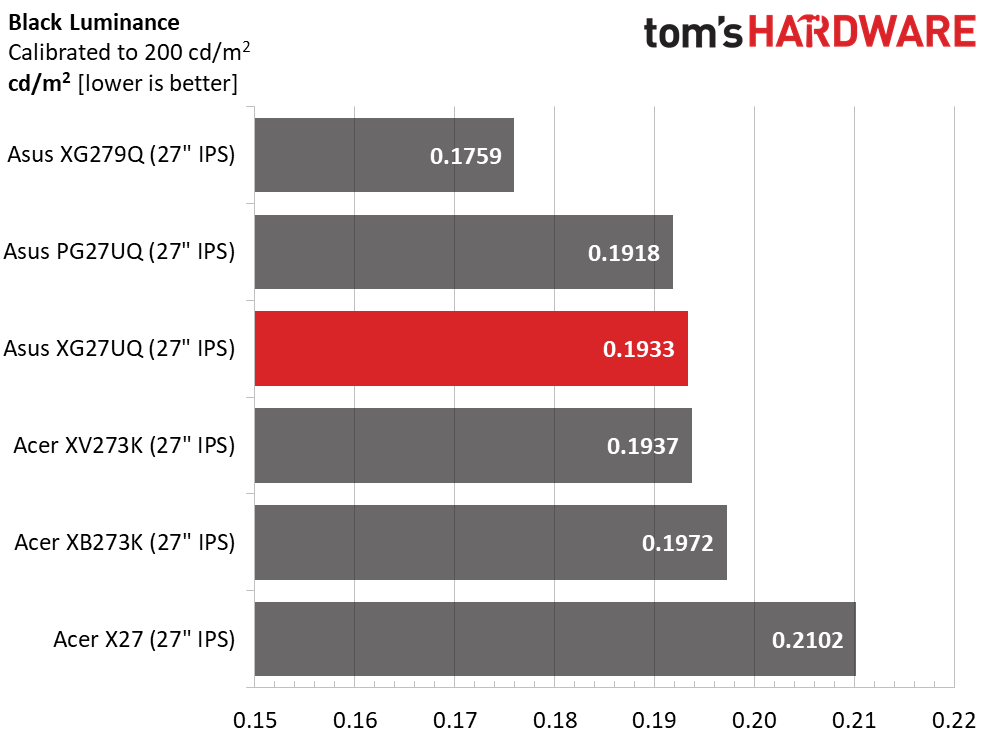
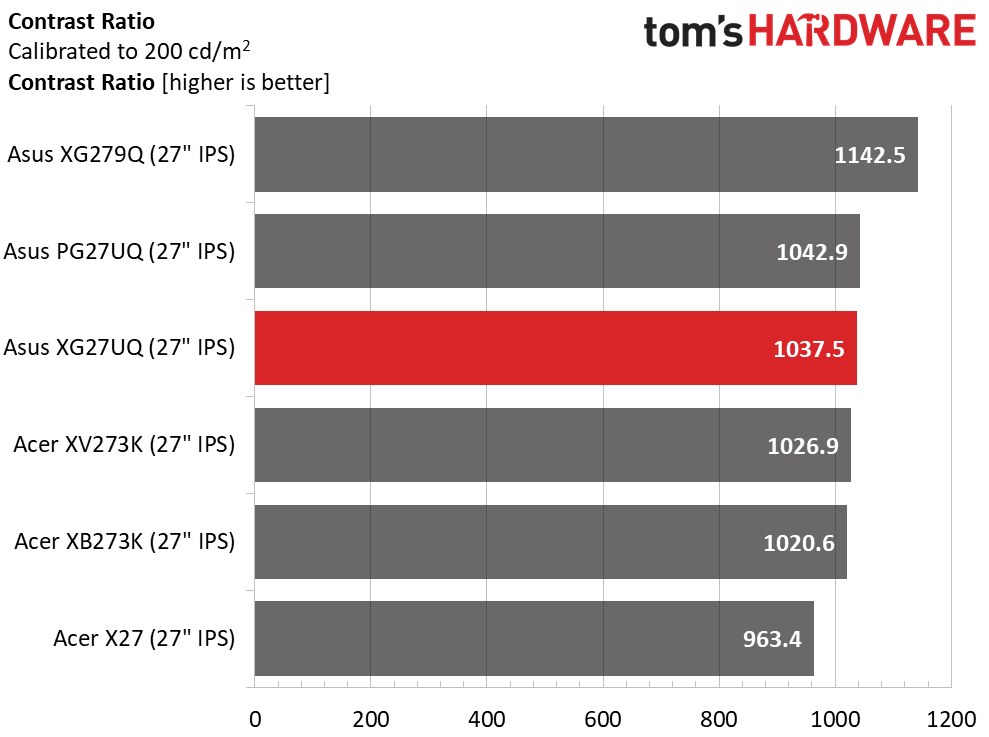
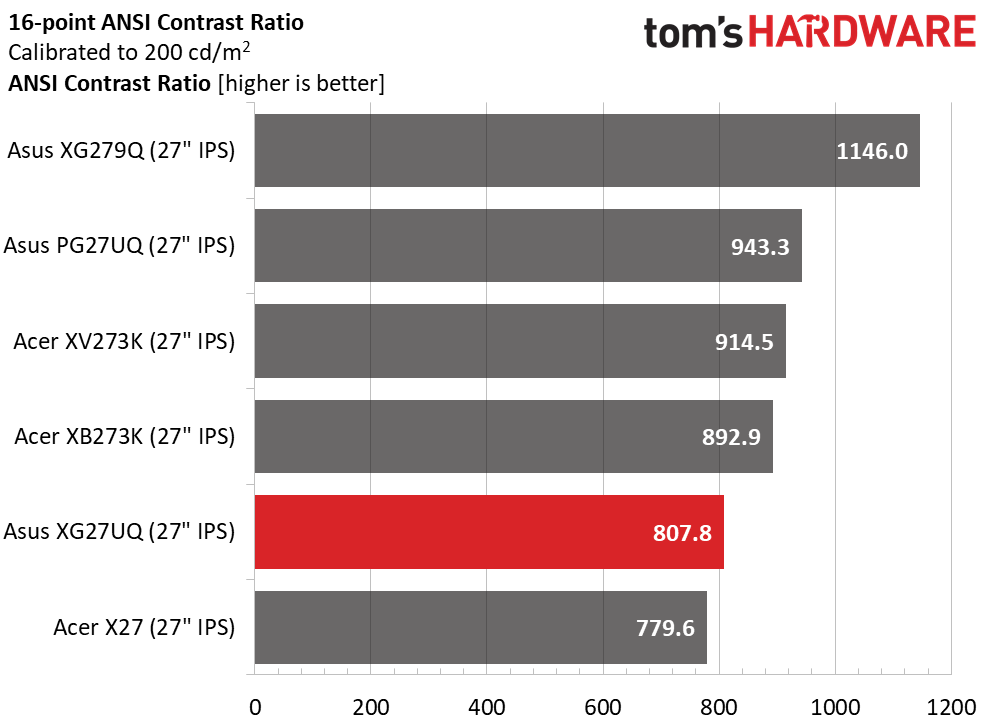
After calibration (see our recommended settings on page 1), black levels and contrast remained mid-pack with a solid 1,057.2:1 score. Whether you calibrate or not, Dynamic Dimming is an effective way to increase image depth and make blacks truer without sacrificing detail.
Our XG27UQ sample had a couple of uniformity issues that lowered the ANSI score. These were seen in the corners of the screen so content in the other zones has a satisfying level of contrast and saturation.
Get Tom's Hardware's best news and in-depth reviews, straight to your inbox.
Current page: Brightness and Contrast
Prev Page Features and Specifications Next Page Grayscale, Gamma and Color
Christian Eberle is a Contributing Editor for Tom's Hardware US. He's a veteran reviewer of A/V equipment, specializing in monitors. Christian began his obsession with tech when he built his first PC in 1991, a 286 running DOS 3.0 at a blazing 12MHz. In 2006, he undertook training from the Imaging Science Foundation in video calibration and testing and thus started a passion for precise imaging that persists to this day. He is also a professional musician with a degree from the New England Conservatory as a classical bassoonist which he used to good effect as a performer with the West Point Army Band from 1987 to 2013. He enjoys watching movies and listening to high-end audio in his custom-built home theater and can be seen riding trails near his home on a race-ready ICE VTX recumbent trike. Christian enjoys the endless summer in Florida where he lives with his wife and Chihuahua and plays with orchestras around the state.
-
law records 1.) Does the monitor have a fan? I've read about how loud monitor fans can be, so the ideal monitor for me wouldn't have one.Reply
2.) Does this panel have FALD? I suspect it doesn't, given the price.
3.) How big a difference is there between Gsync compatible and "proper" G-sync? I have a "proper" G-sync monitor with the chip, but it looks like more and more screens are just going with the "compatible" version which doesn't. I read some of the technical differences, but curious about how noticeable it is when gaming.
I have an 1080ti and will be upgrading to a 3080 once supply stabilizes. -
truerock So, DisplayPort 1.4 supports a maximum of 4K UHD (3840 \00d7 2160) at 60 Hz with 30 bit/px RGB color and HDR .Reply
You couldn't have tested 144MHz.
Oh... I think you may have used compression.
If you use compression I think there should be some details about that in your testing... or at least clearly state: "this is a test with compression" for each test using compression. -
Shadowclash10 I don't think saying it's expensive compared to other 27 inchers is a good con. It's a somewhat premium 4K 144hz monitor, what did you expect? Now, one con is that is has very large and ugly bezels.Reply -
veldrane2 WTB 120Hz+, 4k, sub 4ms, 29-34" monitor.Reply
I've been stuck on 27 inchers for about a decade now. Going to another is not really an upgrade. Double this due to increase in quality of 2k.
So its kinda pointless. We have all this wonderful new hardware cpming out that can finally run 4k really, really well, and monitor manufacturers in general seem to be just derping around instead of pumping out full lines of HBR3 displays.
And no, I don't want it to be TV sized. Not 43", not 55" or whatever else, just an upgrade from not into 27".
Maybe someone at Tom's Hardware could reach out to some of these manufacturers and do a write up about this hold up. Might turn out to be a good topic for an article. -
Bisbus I would definitely second this. There simply aren't any 32" high refresh rate monitors out. Especially with the 3080 coming out it seems manufacturers are caught behind the times.Reply -
excalibur1814 Manufacturers aren't caught behind the times, they're just lazy and will continue to churn out the same, tired, old tech as they're making money. I have a simple, standard, Asus VS248HR which cost £120. It's terrible, but does what it does. I left a reasonable review on Amazon, to which Asus replied as they didn't like what I'd written.Reply
These companies will continue releasing rubbish, at the lower end, to ensure anything above 'standard' affords a premium. Typical, standard, every single day profit. Heck, we'd still be on 1366x768 if they had their way.
P.s. It would be amazing if these companies also made it 100% clear if the 3.5m jack audio/heaphone out was linked to the hdmi port. -
peteer01 Talks about DSC as if it helps with image lag instead of calling it out as necessary compression because DisplayPort 1.4 doesn’t natively support the bandwidth needed for 144Hz 4KReply
Says you can count the number of 4K 144Hz monitors on one hand
Doesn’t bother to list the lack of HDMI 2.1 (which has more bandwidth than DP1.4) under cons or in the part of the article I readI stopped couldn't get through this advertisement. The misinformation is frustrating. I get it, you write reviews that make products look good, but can you avoid lies and misinformation? -
Jackal_x How does it compare to the LG 27GN950?Reply
im pretty stuck atm for what i should buy, maybe its worth waiting to see if theres more options in the next few months with HDMI 2.1 support? -
kyzarvs Replylaw records said:
2.) Does this panel have FALD? I suspect it doesn't, given the price.
Today, we’ll be looking at a less-expensive alternative that delivers everything except the FALD backlight for $800 as of writing. Meet the Asus ROG Strix XG27UQ.
The sentence that includes the price - second paragraph. -
Shadowclash10 Reply
Yeah. Sadly, that;s how the majority of tech companies run. If they have no competition, why push hard and innovate? The only reason is so that an upstart doesn't come along and dethrone them. Just look at Intel! There are so many improvements they could easily make for consumers, but they don't because consumers are "content".excalibur1814 said:Manufacturers aren't caught behind the times, they're just lazy and will continue to churn out the same, tired, old tech as they're making money. I have a simple, standard, Asus VS248HR which cost £120. It's terrible, but does what it does. I left a reasonable review on Amazon, to which Asus replied as they didn't like what I'd written.
These companies will continue releasing rubbish, at the lower end, to ensure anything above 'standard' affords a premium. Typical, standard, every single day profit. Heck, we'd still be on 1366x768 if they had their way.
P.s. It would be amazing if these companies also made it 100% clear if the 3.5m jack audio/heaphone out was linked to the hdmi port.